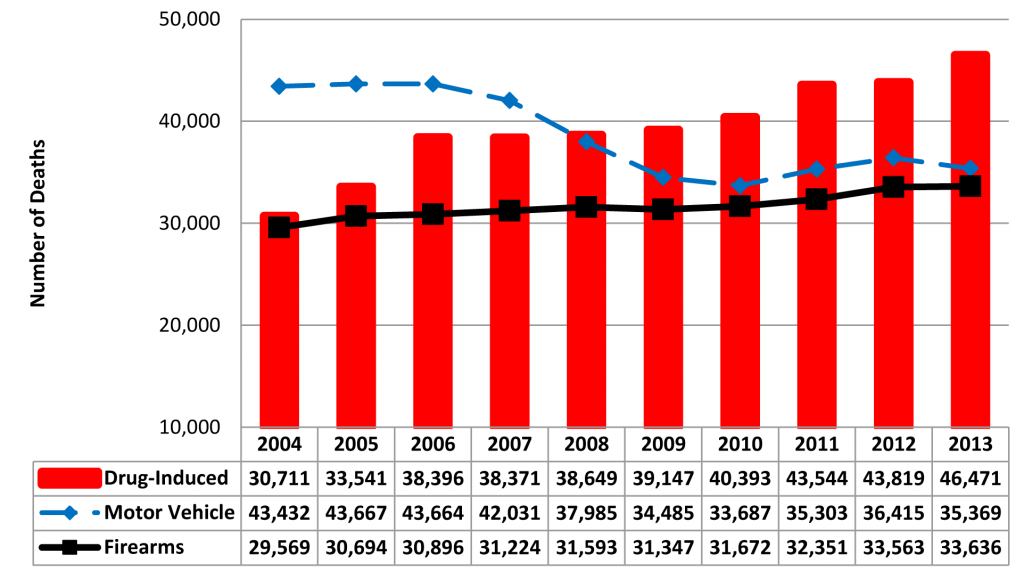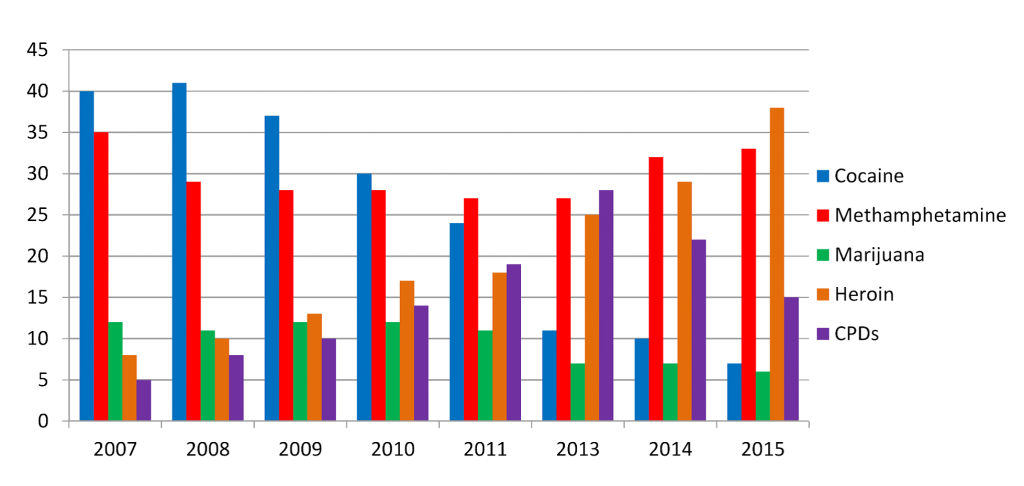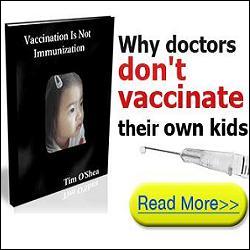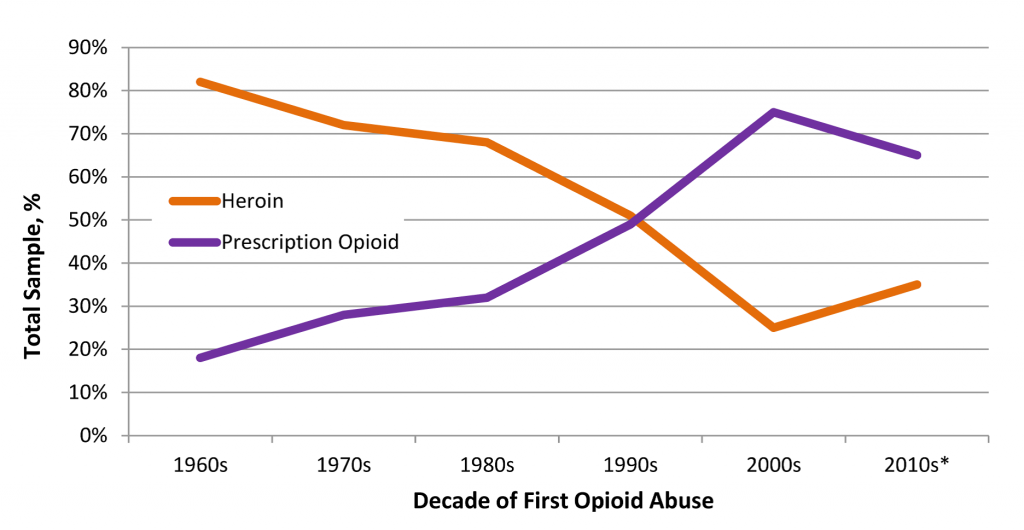The Legal and Illegal Drug Cultures in the USA
Currently, there’s a huge debate about violence, especially firearms violence, in the USA, plus the restriction of gun and other self-defense weapons purchases, which I find amazingly attention-grabbing insofar as there are other causes of deaths that no one really is talking about and, seemingly, doing very little to curb.
The chart below drives home three high-profile killers: Drug-induced, Motor vehicle, and Firearms Deaths. Not surprising to me, at least, is that deaths due to firearms are the least of the three mentioned in 2013, whereas drug-induced drug deaths top out as the highest! Motor vehicle deaths are in the middle.
Widget not in any sidebars
(U) Chart 1. Number of Drug Induced Deaths Compared to the Number of Motor Vehicle and Firearm Deaths, 2004 – 2013
 Chart Source: http://www.dea.gov/docs/2015%20NDTA%20Report.pdf (Pg. ii)
Chart Source: http://www.dea.gov/docs/2015%20NDTA%20Report.pdf (Pg. ii)
Logically and statistically, shouldn’t there be a demand to do away with both controlled prescription drugs and motor vehicles (since they kill more people), in view of the fact that the feds and politicians are calling for firearms disarmament in the USA?
Let me state for the record that I am not a “gun person,” but I do respect the U.S. Constitution and the Bill of Rights.
After all, if the number one killer in the DEA study is drugs—including controlled prescription drugs being responsible for 15 percent of drug threats—shouldn’t Big Pharma be called on the carpet about how they market, advertise, and dispense (physician samples) addictive pharmaceutical drugs?
In 2013 there were 38 percent more drug deaths than firearms deaths! Then again, something else needs to be factored in, questioned and investigated by authorities: Of those firearms deaths, how many shooters were on, or coming off of, controlled prescription drugs, e.g., SSRIs or mood-altering prescription drugs? [5,6,7]
Coincidentally in 2013, controlled prescription drug threats came in close to 28 percent!
(U) Chart 2. Percentage of NDTS Respondents Reporting the Greatest Drug Threat, 2007 – 2015
 CPDs=Controlled Prescription Drugs
CPDs=Controlled Prescription Drugs
Chart Source: http://www.dea.gov/docs/2015%20NDTA%20Report.pdf (Pg. v)
Heroin, according to the DEA report, is now the number one drug threat!
On page 13 of the 2015 National Drug Threat Assessment Summary produced by the U.S. Department of Justice Drug Enforcement Administration (DEA), there’s a listing of metropolitan areas where controlled prescription drugs are ranked according to moderate or high availability. The cities/locales are listed alphabetically, so it’s easy to learn how readers’ regions rank.
 The Percentage of Drug Threats chart indicates the five greatest drug threats. Interestingly, controlled prescription drugs (CPDs) account for 15 percent, whereas marijuana comes in at approximately 6 or 7 percent. The biggest threat is from heroin (38 percent) which, factually, may be a substitute drug of choice due to addiction to CPDs which addicts, who no longer can afford to purchase prescription sources, resort to using.
The Percentage of Drug Threats chart indicates the five greatest drug threats. Interestingly, controlled prescription drugs (CPDs) account for 15 percent, whereas marijuana comes in at approximately 6 or 7 percent. The biggest threat is from heroin (38 percent) which, factually, may be a substitute drug of choice due to addiction to CPDs which addicts, who no longer can afford to purchase prescription sources, resort to using.
Just the other day I heard a radio news report (KYW Philadelphia, PA) that stated those who get hooked on CPDs, and no longer can afford to purchase them, can find and purchase heroin for as little as $10 a pop! What does that tell us about the role that pharmaceuticals carelessly play in establishing an illegal drug culture?
The chart below, which appears on page 32 of the DEA report, indicates how numerous heroin addicts get started by using either heroin or opioid Rx drugs. Currently, the trend is Prescription Opioids. As prescription opioids availability and use rose, heroin habits declined. Again, what does that point to about Big Pharma products contributing to an illegal drug culture?
(U) Chart 16. Percentage of the Total Heroin-Dependent Sample that Used Heroin or a Prescription Opioid as Their First Opioid of Abuse
 In the United States there are two very profitable drug cultures: an illegal one [cartels and pushers] and legal pharmaceuticals, i.e., MDs issuing legal scripts for controlled substances. However, the illegal drug culture finds itself being sought out and prosecuted, whereas the legal pharma pushers seem to be exempt. Why not? since MDs have licenses and prescription pads that, unfortunately, can do a lot of harm.
In the United States there are two very profitable drug cultures: an illegal one [cartels and pushers] and legal pharmaceuticals, i.e., MDs issuing legal scripts for controlled substances. However, the illegal drug culture finds itself being sought out and prosecuted, whereas the legal pharma pushers seem to be exempt. Why not? since MDs have licenses and prescription pads that, unfortunately, can do a lot of harm.
What I think government officials, and society in general, need to be questioning—plus investigating—is this: How do Big Pharma incentives to physicians for prescribing their controlled, toxic drugs program and participate in the distribution, sales and uses of legal/illegal pharmaceutical drugs?
Before the industry’s chief lobbying group, Pharmaceutical Research and Manufacturers of America, in 2002 pulled the plug, the open use of gifts and money to influence doctors was considered standard practice. [1]
Pharmaceutical companies certainly know how to merchandise their poisons! Pharmaceuticals really are chemical poisons, controlled by prescriptions, due to the fact they are industry-made, patented, dangerous chemicals.
 Graphic Source: http://www.drugwatch.com/how-big-pharma-influences-doctors.php
Graphic Source: http://www.drugwatch.com/how-big-pharma-influences-doctors.php
So now, how does Big Pharma accomplish a work-around?
Doctors Hired as Paid Speakers
Today, if a drug company wishes to get a doctor to write more prescriptions, it will simply ask him or her to become a speaker – or, as it’s known in the trade, a “thought leader.” Tens of thousands of U.S. physicians are paid to spread the word about Big Pharma’s favored pills. [….]
But a recent investigation by ProPublica, a non-profit corporation that produces investigative journalism in the public interest, found on company payrolls hundreds of doctors accused of professional misconduct and disciplined by state boards or one that lacked credentials as researchers or specialists. [1]
In the April 2014 article “Should drug firms make payments to doctors?” this appeared:
Prescribe enough drugs and – as detailed in 1974 Senate hearings – a doctor could accumulate points to exchange for a wide range of consumer desirables – colour [sic] TVs, watches, microwave ovens, lawnmowers, golf clubs. [2] [….]
In the decades that followed, the pharmaceutical industry grew and the stakes got bigger. As more information about doctors’ prescribing habits became available, more money was spent trying to influence them. [2]
A 61-page report, “Financial Conflicts of Interest in Medicine” (January 2014), states that
This possibility [financial relationships with doctors] has not gone unnoticed by legislators. Beginning in 2014, the Physician Payments Sunshine Act took effect, when drug and medical device manufacturers will be required to publicly report payments to physicians and teaching hospitals (Centers for Medicare & Medicaid Services, 2013). A presumption underlying this legislation is that transfers from the medical industry create conflicts of interest for providers that, in turn, influence their behavior. This paper evaluates that presumption.
One of the possibilities for payments to physicians by Big Pharma is that ‘drug companies convince physicians that certain drugs are better than others, when in reality they are not.’ [3]
In that report’s Conclusion, it states in part:
Using data from twelve drug companies, more than 330,000 physicians and nearly one billion prescriptions, we find that when a drug company pays a doctor he is more likely to prescribe that company’s drug. [4]
One billion prescriptions and only twelve drug companies! That represents a script for close to one-seventh of the world’s population. Physicians receive perks from Big Pharma, which should be illegal and considered similar to the insurance industry’s rebating that was regulated and outlawed [8].
Big Pharma and the medical profession need to be bridled more strictly, and statutorily, because of their influences on the availability of controlled prescription drugs impacting “pharma-junkie” addicts, and prescriptions can be acquired from licensed health professionals rather very easily.
References:
[1] http://www.drugwatch.com/how-big-pharma-influences-doctors.php
[2] http://www.bbc.com/news/magazine-26890072
[3] http://rady.ucsd.edu/faculty/directory/engelberg/pub/portfolios/DOCTORS.pdf Pg. 25
[4] Ibid. Pg. 38
[5] http://www.naturalnews.com/039752_mass_shootings_psychiatric_drugs_antidepressants.html
[6] http://www.cchrint.org/school-shooters/
[7] http://www.wnd.com/2015/06/big-list-of-drug-induced-killers/
[8] http://hnas.com/LinkClick.aspx?fileticket=UWZdtOBp_uw=
Catherine J Frompovich (website) is a retired natural nutritionist who earned advanced degrees in Nutrition and Holistic Health Sciences, Certification in Orthomolecular Theory and Practice plus Paralegal Studies. Her work has been published in national and airline magazines since the early 1980s. Catherine authored numerous books on health issues along with co-authoring papers and monographs with physicians, nurses, and holistic healthcare professionals. She has been a consumer healthcare researcher 35 years and counting.
Catherine’s latest book, published October 4, 2013, is Vaccination Voodoo, What YOU Don’t Know About Vaccines, available on Amazon.com.
Her 2012 book A Cancer Answer, Holistic BREAST Cancer Management, A Guide to Effective & Non-Toxic Treatments, is available on Amazon.com and as a Kindle eBook.
Two of Catherine’s more recent books on Amazon.com are Our Chemical Lives And The Hijacking Of Our DNA, A Probe Into What’s Probably Making Us Sick (2009) and Lord, How Can I Make It Through Grieving My Loss, An Inspirational Guide Through the Grieving Process (2008)



